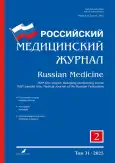The role of patient education in hypertension management as part of outpatient follow-up
- Authors: Abdrakhmanov A.R.1, Polunin V.S.1, Tyazhelnikov A.A.1
-
Affiliations:
- Pirogov Russian National Research Medical University
- Issue: Vol 31, No 2 (2025)
- Pages: 100-110
- Section: Original Research Articles
- Submitted: 25.03.2025
- Accepted: 07.04.2025
- Published: 27.04.2025
- URL: https://medjrf.com/0869-2106/article/view/677729
- DOI: https://doi.org/10.17816/medjrf677729
- ID: 677729
Cite item
Abstract
BACKGROUND: Hypertension is a major medical and social issue that requires effective preventive measures. Physician-led health education plays a critical role in enhancing patient adherence to nonpharmacological methods of prevention and treatment. However, the effectiveness and comprehensiveness of the recommendations provided remain insufficiently studied.
AIM: To evaluate patient education provided by physicians to working-age individuals under outpatient follow-up for hypertension.
METHODS: A survey of 350 patients aged 30–50 years under outpatient follow-up for hypertension was conducted, along with an analysis of their medical records using statistical methods.
RESULTS: It was found that in 84% of cases, physicians documented preventive recommendations (such as reducing salt intake and keeping a self-monitoring diary) in the medical records. These recommendations often failed to take individual patient characteristics into account. A significant association was found between the comprehensiveness of the recommendations and patient adherence: patients who received more detailed and personalized advice showed higher levels of adherence.
CONCLUSION: Physician-led patient education for individuals with hypertension should be enhanced by tailoring recommendations to individual needs, incorporating telemedicine consultations, referring patients to outpatient health schools, developing educational resources, and implementing digital monitoring tools. The findings of this study may contribute to enhancing preventive care programs within the framework of outpatient follow-up for patients with hypertension.
Keywords
Full Text
About the authors
Ainur R. Abdrakhmanov
Pirogov Russian National Research Medical University
Email: abdrakhmanovaynur@yandex.ru
ORCID iD: 0000-0003-3504-4196
SPIN-code: 1667-7272
Russian Federation, Moscow
Valery S. Polunin
Pirogov Russian National Research Medical University
Author for correspondence.
Email: lunapol@yandex.ru
ORCID iD: 0000-0002-2681-8527
SPIN-code: 3491-4908
MD, Dr. Sci. (Medicine), Professor
Russian Federation, MoscowAndrey A. Tyazhelnikov
Pirogov Russian National Research Medical University
Email: tyazhelnikovAA@zdrav.mos.ru
ORCID iD: 0000-0002-2191-0623
SPIN-code: 4251-4544
MD, Dr. Sci. (Medicine), Associate Professor, Professor
Russian Federation, MoscowReferences
- Tregubov VN, Polukhin NV, Vodolagin MV. Analysis of works of N.A. Semashko on public health education. (To the 150th anniversary of the birth). Russian Journal of Preventive Medicine and Public Health. 2023;26(9):125–130. doi: 10.17116/profmed202326091125 EDN: IPOSGC
- Arterial hypertension in adults. Clinical guidelines 2020. Russian Journal of Cardiology. 2020;25(3):3786. (In Russ.) doi: 10.15829/1560-4071-2020-3-3786
- Balanova YuA, Drapkina OM, Kutsenko VA, et al. Hypertension in the Russian population during the COVID-19 pandemic: sex differences in prevalence, treatment and its effectiveness. Data from the ESSE-RF3 study. Cardiovascular Therapy and Prevention. 2023;22(8S):105–120. doi: 10.15829/1728-8800-2023-3785 EDN: YRUNUX
- Dickinson HO, Mason JM, Nicolson DJ, et al. Lifestyle interventions to reduce raised blood pressure: a systematic review of randomized controlled trials. Journal of Hypertension. 24(2):215–233. doi: 10.1097/01.hjh.0000199800.72563.26 EDN: WVBZTT
- Whelton PK, Carey RM, Aronow WS, et al. ACC/AHA.AAPA.ABC.ACPM.AGS.APhA.ASH.ASPC.NMA.PCNA Guideline for the prevention, detection, evaluation, and management of high blood pressure in adults: a report from the American College of Cardiology. American Heart Association Task Force on Clinical Practice Guidelines. J Am Coll Cardiol. 2018;71(19):2273–2275. doi: 10.1016/j.jacc.2017.11.005 EDN: YHSAPZ
- Polunina NV. Public health and healthcare. Moscow: Publishing house “Medical Information Agency”; 2010. 544 p. (In Russ.)
- Kalinina AM, Gomova TA, Kushunina DV, et al. Prophylactic activity of outpatients as an important factor of the efficiency of prophylactic medical examination and case follow-up: regional experience. Russian Journal of Preventive Medicine and Public Health. 2015;18(2-1):4–10. doi: 10.17116/profmed20151824-10 EDN: UGZGRZ
- Puzin SN, Shurgaya MA, Chandirli SA, et al. Aspects of medical and social rehabilitation of patients with essential hypertension. Medical and Social Expert Evaluation and Rehabilitation. 2014;1:10–15. EDN: SILHEV
- Eckert N, Mikhaylovski VV. "Health schools" as the key factor of efficient cardiovascular disease prevention. Sechenov Medical Journal. 2016;2(24):58–62. EDN: VXIFJI
- Skvortsov VV, Tagiev FZ, Volodina DM. School of health for patients with arterial hypertension. Meditsinskaya sestra (The Nurse). 2023;25(3):34–38. doi: 10.29296/25879979-2023-03-07 EDN: PTCWFU
- Korshun YuI, Vazap VA, Sidorenya AD, et al. Molodoj uchjonyj. 2018;14:124–125. (In Russ.) EDN: YVJXHE
- Agranovich NV, Knyshova SA, Anopchenko AS, et al. The need for the development and significance of the “School of the patient” in the complex therapy of hypertension. Modern Problems of Science and Education. 2018;(1):75. EDN: YPOFVU
- Lakhman EYu. School of health as a method of secondary prevention of mild and moderate arterial hypertension in outpatient settings [dissertation abstract]. Moscow; 2005. (In Russ.) EDN: NIAUNP
- Shemetova GN, Ryaboshapko AI, Gubanova GV. The role of schools for patients in the secondary prevention of arterial hypertension. Saratov Journal of Medical Scientific Research. 2017;13(3):481–483. EDN: YPTYHT
- Kudryavtseva SA. Methods of optimizing the treatment of patients with hypertension: medicinal and non-medicinal methods and their combinations. Vladimir: Transit-IKS, 2019.
Supplementary files














